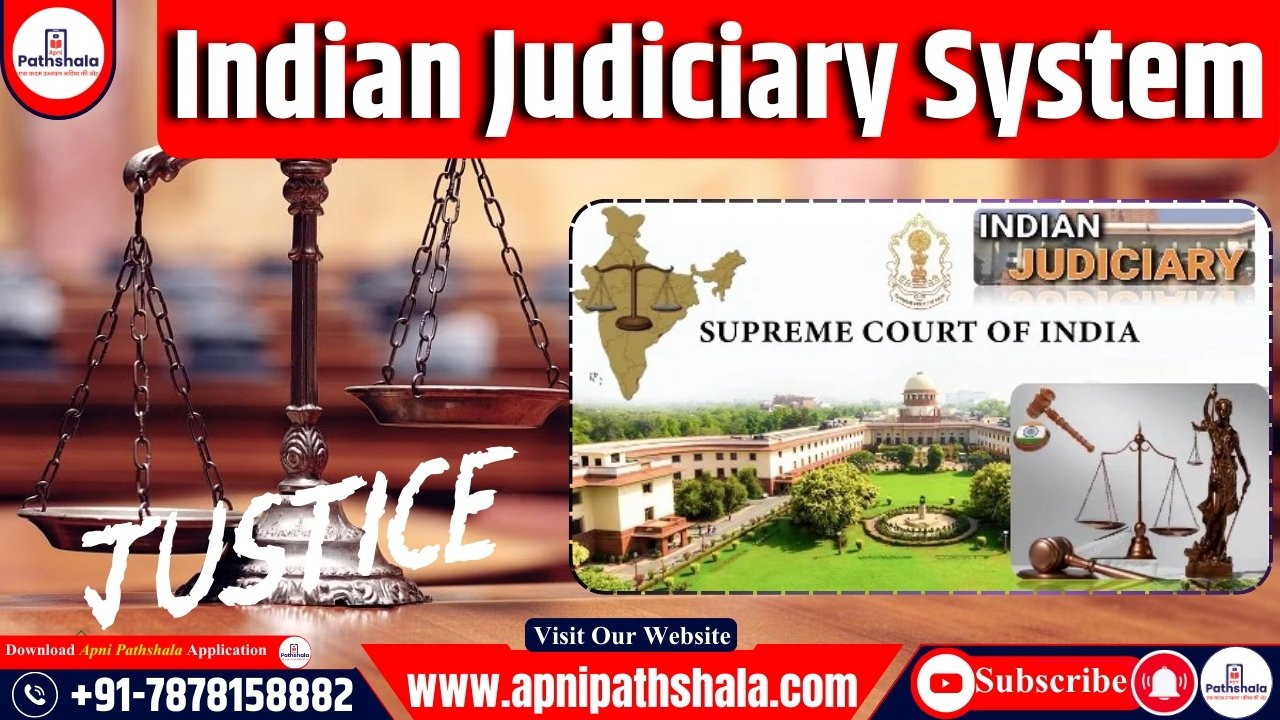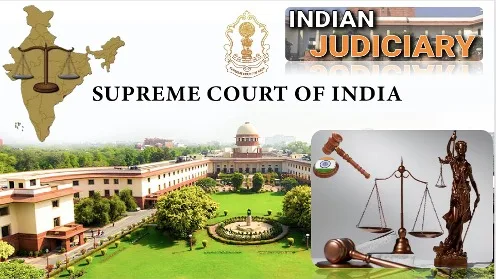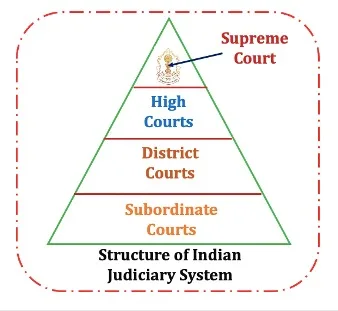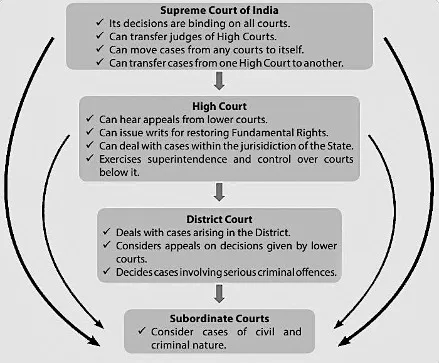What’s in this Article?
- Table of Contents
- What is Judiciary?
- History of Judiciary System in India.
- Structure of Indian Judiciary System.
- Functions/Role of Indian Judiciary.
- Challenges Faced by Indian Judiciary.
- Conclusion
- FAQs
- MCQs
What is Judiciary?
- The judiciary is the branch of government responsible for interpreting laws, settling disputes, and ensuring justice in accordance with the constitution.
- It includes courts, judges, and legal systems tasked with applying and upholding the law fairly and impartially, thus safeguarding the rights and liberties of citizens within a legal framework.
- The legislative, the executive branch, and the judiciary are the three pillars that uphold the Indian government.
- The judiciary is independent in India.
- The other arms of government cannot impede the functioning of the judiciary.
- The government’s judiciary branch is in charge of applying the law, settling disputes, and ensuring that every citizen receives justice.
History of Judiciary System in India
- The Indian judicial system’s historical background can be traced back to:
- Ancient Period
- Village panchayats, which were in existence during the Vedic era, handled minor conflicts.
- Under the direction of Dharma Mahamatyas, Chandragupta Maurya constructed an organized court system in the Mauryan Empire.
- Chandragupta Maurya created a systematized legal system during the Mauryan era, employing Dharma Mahamatyas as judges to settle cases in accordance with the Dharma Shastras.
- During the Gupta era, royal courts adjudicated more serious crimes and civil issues; village panchayats continued to settle local conflicts.
- Mughal Era
- Qazis enforced Islamic law for Muslims during the Mughal era, whereas pandits administered Hindu law to Hindus.
- The highest court of appeal was the emperor.
- During the Colonial Period
- During this period, the Britishers initiated the establishment of courts to oversee their commercial activities, with the Sadr Diwani Adalat serving as the apex court.
- The Regulating Act of 1773 led to the creation of the Supreme Court in Calcutta, which was subsequently relocated to Delhi.
- The Charter Act of 1833 granted the Governor General authority to implement legislative and judicial changes.
- Additionally, under the British judicial system, High Courts were established in significant provinces (Calcutta had the first high court, followed by Bombay and Madras) in 1862.
- Thereafter, as per the Government of India Act, of 1935, the national court was established having a broader jurisdiction as compared to the high courts.
- Post Independence
- The history of the Indian Judiciary culminated with its independence and the establishment of the Supreme Court.
- Following India’s independence in 1947, the Judiciary underwent significant reforms, aiming for impartiality and autonomy.
- The Constitution of India, adopted in 1950, established the Supreme Court of India as the highest judicial authority, separating it from the Executive.
- This marked a pivotal moment, ensuring the Judiciary’s independence and its crucial role in upholding justice and the rule of law.
- The Supreme Court’s formation symbolized India’s commitment to a robust legal framework and served as the cornerstone of its democratic institutions, fostering transparency and accountability.
Structure of Indian Judiciary System
- Judicial Hierarchy in India
- Structure of Judiciary in India
- The judicial system in India functions as a unified entity, with a hierarchical structure.
- Positioned at the pinnacle is the Supreme Court (SC), overseeing the lower tiers composed of District and Subordinate Courts, followed by the High Courts.
- The upper courts hold authority over the functioning of the lower courts, as depicted in the accompanying visual representation of India’s judicial hierarchy.
- Supreme Court of India
- The Supreme Court of India, established on January 28, 1950, holds the distinction of being the largest court in the nation.
- Serving as the ultimate appellate body, it hears both original cases and appeals against decisions made by High Courts.
- Comprising the Chief Justice of India and a panel of 33 judges (full strength of 34), the Supreme Court’s jurisdiction is delineated in Articles 124 to 147 of the Indian Constitution.
- High Courts
- The supreme legal authority within each state is the High Court.
- Article 214 outlines the scope of jurisdiction for High Courts.
- There are 25 High Courts in the country, three having jurisdiction over more than one State.
- High Courts preside over criminal or civil matters only when lower state courts are incapable of doing so.
- High Courts may also address appeals from subordinate courts.
- Judges for the High Court are appointed by the President of India upon recommendation from the Chief Justice of the High Court, in consultation with the Governor of the respective state.
- District Courts
- District Courts in India serve as the primary trial courts for civil and criminal cases at the district level.
- There are commonly two kinds of courts in every district, Civil Courts and Criminal Courts.
- These courts handle a diverse range of cases, including civil disputes, criminal offenses, family matters, and more.
- District Judges preside over these courts, aided by additional judges and magistrates.
- District Courts play a crucial role in delivering justice and upholding the rule of law at the grassroots level, ensuring access to justice for millions of citizens.
- Lok Adalat/Village Courts
- These subordinate courts at the village level provide a different approach to resolving disputes in villages, refferes as “People’s Court”.
- These Adalat are made up of retired or serving judicial authorities as well as other people as defined by the Central Government.
- The Legal Services Authorities Act,1987 established a judicial post on the Lok Adalat.
- The Lok Adalat is called before the tribunal to discuss ongoing legal matters, and the Adalat has jurisdiction over those cases.
- Tribunals
- The Constitution gives the executive branch the authority to establish specialized tribunals to handle particular situations, such as those involving taxes, real estate, consumers, etc.
- These courts can either possess quasi-judicial or fully judicial powers and serve to alleviate the workload of traditional courts.
- Article 323A empowers Parliament to establish administrative tribunals at both state and central levels, while Article 323B outlines a list of subjects for which tribunals are designated by either state legislatures or the national Parliament.
- Appellate jurisdiction
- Appellate jurisdiction pertains to a court’s ability to review and reassess a case previously decided by a lower court.
- Both the Supreme Court and the High Courts of India possess this authority, enabling them to uphold or overturn rulings made by lower courts.
- The Supreme Court holds three distinct jurisdictions: advisory, appellate, and original, as outlined in various articles of the Constitution such as Articles 131, 133, 136, and 143, which delineate its powers and responsibilities.
- Civil and Criminal Law
S.No. | Civil Law | Criminal Law |
1. | It deals with any harm or injury to the rights of individuals. As: Disputes relating to the sale of land, purchase of goods, rent, matters, and divorce cases. | It deals with the conduct or acts that law defines as offenses. As: Theft, harassing a woman to bring more dowry, murder etc. |
2. | In the Indian legal system, a petition must be submitted to the appropriate court by the party directly impacted. | It typically commences by filing a First Information Report (FIR) with the police who are probing the offense, followed by initiating legal proceedings with a court case. |
3. | The court grants the exact remedy requested. | If proven culpable, the defendant may face imprisonment along with monetary penalties. |
Functions/Role Of Indian Judiciary
- The Indian judiciary plays a crucial role in upholding the rule of law, protecting fundamental rights, and ensuring justice for all citizens. Here are some of the top points outlining the functions and roles of the Indian judiciary:
- Guardian of the Constitution: The judiciary, particularly the Supreme Court of India, acts as the guardian of the Indian Constitution. It ensures that all laws and actions of the government are in conformity with the Constitution and can strike down any law that violates its provisions.
- Interpreting Laws: One of the primary functions of the judiciary is to interpret laws enacted by the legislature. It resolves disputes by applying the relevant statutes, precedents, and principles of law to the facts of each case.
- Protection of Fundamental Rights: The judiciary safeguards the fundamental rights guaranteed by the Constitution, such as the right to equality, right to freedom of speech and expression, right to life and personal liberty, etc. It can issue writs like habeas corpus, mandamus, prohibition, certiorari, and quo warranto to protect these rights.
- Adjudication of Disputes: The judiciary resolves disputes between individuals, between individuals and the state, and between different branches of the government. It provides a forum for the peaceful resolution of conflicts through fair and impartial adjudication.
- Judicial Review: The judiciary has the power of judicial review, allowing it to review the constitutionality of laws passed by the legislature and actions taken by the executive. It ensures that governmental actions do not exceed the powers granted to them by the Constitution.
- Check on Executive and Legislative Powers: Through judicial review, the judiciary acts as a check on the powers of the executive and legislative branches of government. It ensures that these branches do not abuse their authority or violate the rights of citizens.
- Public Interest Litigation (PIL): The Indian judiciary has pioneered the concept of PIL, allowing citizens to seek judicial intervention in matters of public interest. PILs have been instrumental in addressing various social, environmental, and human rights issues.
- Settlement of Constitutional Disputes: The judiciary resolves disputes arising between the central government and state governments, between different states, and between the states and union territories concerning the interpretation of the Constitution.
- Appointment and Transfer of Judges: The judiciary is involved in the appointment and transfer of judges within the judicial hierarchy. The collegium system, consisting of senior judges, plays a significant role in these processes.
- Judicial Activism: At times, the Indian judiciary engages in judicial activism by taking proactive measures to protect the rights of citizens and ensure accountability and transparency in governance.
- Overall, the Indian judiciary serves as a vital pillar of democracy by upholding the rule of law, protecting fundamental rights, and ensuring justice for all segments of society.
Challenges Faced by Indian Judiciary
- The Indian Judiciary faces several challenges, which can broadly be categorized into systemic, procedural, and resource-related issues. some of the top points outlining these challenges:
- Backlog of Cases: One of the most pressing challenges is the backlog of cases in Indian courts. The sheer volume of pending cases leads to delays in justice delivery, undermining the efficiency and effectiveness of the judiciary.
- Slow Judicial Process: The Indian legal system is often criticized for its slow judicial process. Cases can take years, if not decades, to reach a resolution, leading to frustration among litigants and diminishing public trust in the judiciary.
- Overburdened Judiciary: The number of judges in proportion to the population is significantly lower in India compared to many other countries. This results in an overburdened judiciary, further exacerbating delays in the disposal of cases.
- Infrastructure and Technology: Inadequate infrastructure and technological integration hinder the efficient functioning of courts. Many courts still rely on outdated methods of record-keeping and communication, which contribute to delays and inefficiencies.
- Access to Justice: There are disparities in access to justice, particularly for marginalized and economically disadvantaged populations. High legal costs, procedural complexities, and geographical barriers often prevent many individuals from seeking redress through the legal system.
- Quality of Legal Representation: The quality of legal representation can vary widely, with many litigants unable to afford competent legal assistance. This can result in unequal treatment before the law and undermine the principles of justice and fairness.
- Judicial Independence and Accountability: While judicial independence is a cornerstone of democracy, maintaining a balance between independence and accountability is crucial. Challenges related to judicial accountability, transparency, and integrity have been raised at various levels.
- Archaic Laws and Procedures: Many laws and procedural rules in India are outdated and in need of reform. The complexity and ambiguity of legal provisions can contribute to prolonged litigation and impede the swift resolution of disputes.
- Enforcement of Judgments: Even after obtaining a favorable judgment, litigants often face challenges in enforcing it. Inefficiencies in the execution process can undermine the efficacy of court orders and deter compliance with legal obligations.
- Public Perception and Trust: Public perception of the judiciary influences its legitimacy and effectiveness. Instances of corruption, bias, and judicial misconduct can erode public trust in the judiciary, highlighting the need for transparency and accountability measures.
- Addressing these challenges requires comprehensive reforms aimed at enhancing judicial efficiency, accessibility, and integrity. This may involve increasing judicial capacity, investing in modern infrastructure and technology, simplifying legal procedures, promoting legal literacy, and ensuring greater transparency and accountability within the judiciary.
Conclusion
- The Indian Judiciary system plays a pivotal role in upholding the rule of law and ensuring justice for all citizens.
- Despite facing challenges such as backlog of cases and delays in the legal process, it remains a cornerstone of democracy, safeguarding fundamental rights and liberties.
- With a complex hierarchy of courts and a commitment to impartiality, it strives to maintain transparency and accountability.
- However, there is ongoing debate regarding reforms to enhance efficiency and accessibility, addressing issues of judicial independence and judicial activism.
- Overall, the Indian Judiciary system continues to evolve, adapting to societal changes while upholding the principles of justice and equality.
Frequently Asked Questions (FAQ’s)
Question: What is the structure of the Indian judiciary system?
Ans: The Indian judiciary system comprises the Supreme Court of India at the top, followed by High Courts at the state level, and subordinate courts which include District Courts, Sessions Courts, and various special courts.
Question: What is the role of the Supreme Court of India?
Ans: The Supreme Court is the highest judicial authority in India. It has both original and appellate jurisdiction, and its main role is to interpret the Constitution, settle disputes between the Union government and states, and uphold the rule of law.
Question: How are judges appointed in India?
Ans: Judges in the Supreme Court and High Courts are appointed by the President of India based on the recommendations of a collegium system, which consists of the Chief Justice of India and a group of senior judges.
Question: What are the functions of High Courts in India?
Ans: High Courts have jurisdiction over a particular state or a group of states and union territories. They serve as courts of appeal, exercise original jurisdiction over cases involving high monetary value or cases involving constitutional matters, and they also have supervisory jurisdiction over subordinate courts.
Question: What are the different types of courts in India?
Ans: India has a hierarchical structure of courts. Apart from the Supreme Court and High Courts, there are District Courts, Sessions Courts, Magistrate Courts, Family Courts, Tribunals, and various specialized courts for specific matters like labor disputes, consumer grievances, and taxation.
Question: How are legal disputes resolved in India?
Ans: Legal disputes in India can be resolved through various means such as litigation in courts, alternative dispute resolution methods like mediation, arbitration, and conciliation, as well as through statutory bodies and tribunals set up for specific types of disputes.
Question: What is Public Interest Litigation (PIL) in India?
Ans: Public Interest Litigation is a legal action initiated in a court of law for the enforcement of public interest or general interest in cases where the aggrieved party might not be able to approach the court directly. It is an important tool for social activism in India.
Question: How does the Indian judiciary ensure independence?
Ans: The Indian judiciary enjoys independence through various measures such as the appointment process of judges, security of tenure, fixed salaries, and separation of powers. The Constitution provides for the separation of powers among the executive, legislature, and judiciary to prevent undue influence.
Question: What is the significance of judicial activism in India?
Ans: Judicial activism refers to the willingness of the judiciary to intervene in matters of public interest, even in cases where there is no direct legal dispute brought before it. It has played a crucial role in expanding the scope of fundamental rights and ensuring accountability of the government.
Q: What is the highest judicial authority in India?
(A) Supreme Court
(B) High Court
(C) District Court
(D) Constitutional Court
Ans: (A) Supreme Court
Q: How many judges sit on the bench of the Supreme Court of India?
(A) 25
(B) 33
(C) 34
(D) None
Ans: (C) 34
Q: Who appoints judges to the Supreme Court of India?
(A) President of India
(B) Prime Minister of India
(C) Chief Justice of India
(D) Parliament of India
Ans: (A) President of India
Q: Which article of the Indian Constitution deals with the independence of the judiciary?
(A) Article 124
(B) Article 50
(C) Article 32
(D) Article 124A
Ans: (B) Article 50
Q: What is the retirement age of judges of the Supreme Court of India?
(A) 60 years
(B) 62 years
(C) 65 years
(D) 70 years
Ans: (C) 65 years
Q: How many types of courts are there in India’s judicial system?
(A) 2
(B) 3
(C) 4
(D) 5
Ans: (C) 4
Q: Who is the head of the judiciary in a state in India?
(A) Chief Justice of India
(B) President of India
(C) Governor of the state
(D) The High Court of state
Ans: (D) The High Court of state
Q: What is the function of the High Court in India?
(A) It hears appeals from lower courts
(B) It acts as the highest appellate court
(C) It deals with constitutional matters
(D) All of the above
Ans: (D) All of the above
Q: How are judges of the High Court appointed?
(A) By the President of India
(B) By the Governor of the state
(C) By the Chief Justice of India
(D) By the Prime Minister
Ans: (A) By the President of India
Q: Which of the following is not a fundamental right guaranteed by the Indian Constitution?
(A) Right to Equality
(B) Right to Education
(C) Right to Property
(D) Right to Freedom of Religion
Ans: (C) Right to Property
Disclaimer: The article may contain information pertaining to prior academic years; for further information, visit the exam’s “official or concerned website“.
Explore our courses: https://apnipathshala.com/courses/
Explore Our test Series: https://tests.apnipathshala.com/


























